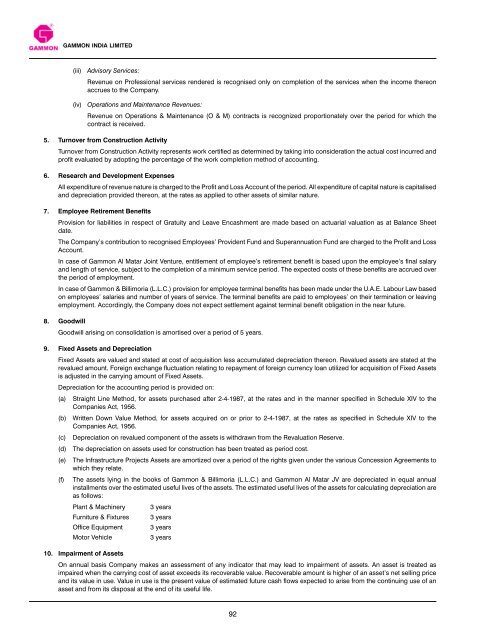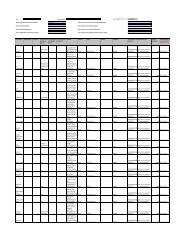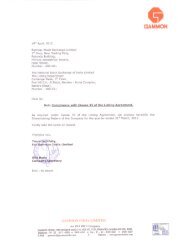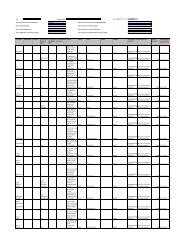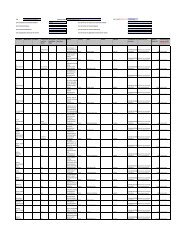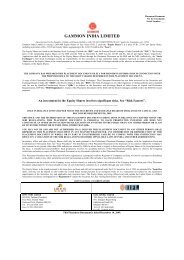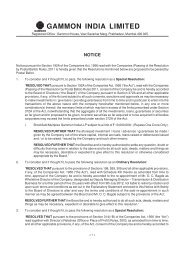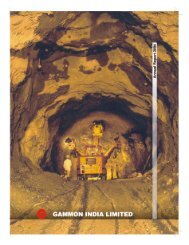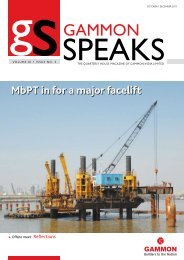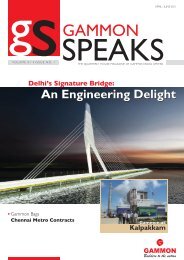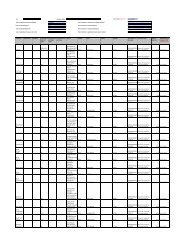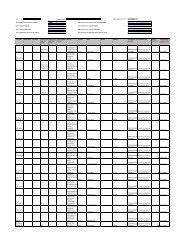Annual Report 2006-2007 - Gammon India
Annual Report 2006-2007 - Gammon India
Annual Report 2006-2007 - Gammon India
You also want an ePaper? Increase the reach of your titles
YUMPU automatically turns print PDFs into web optimized ePapers that Google loves.
GAMMON INDIA LIMITED<br />
(iii) Advisory Services:<br />
Revenue on Professional services rendered is recognised only on completion of the services when the income thereon<br />
accrues to the Company.<br />
(iv) Operations and Maintenance Revenues:<br />
Revenue on Operations & Maintenance (O & M) contracts is recognized proportionately over the period for which the<br />
contract is received.<br />
5. Turnover from Construction Activity<br />
Turnover from Construction Activity represents work certified as determined by taking into consideration the actual cost incurred and<br />
profit evaluated by adopting the percentage of the work completion method of accounting.<br />
6. Research and Development Expenses<br />
All expenditure of revenue nature is charged to the Profit and Loss Account of the period. All expenditure of capital nature is capitalised<br />
and depreciation provided thereon, at the rates as applied to other assets of similar nature.<br />
7. Employee Retirement Benefits<br />
Provision for liabilities in respect of Gratuity and Leave Encashment are made based on actuarial valuation as at Balance Sheet<br />
date.<br />
The Company’s contribution to recognised Employees’ Provident Fund and Superannuation Fund are charged to the Profit and Loss<br />
Account.<br />
In case of <strong>Gammon</strong> Al Matar Joint Venture, entitlement of employee’s retirement benefit is based upon the employee’s final salary<br />
and length of service, subject to the completion of a minimum service period. The expected costs of these benefits are accrued over<br />
the period of employment.<br />
In case of <strong>Gammon</strong> & Billimoria (L.L.C.) provision for employee terminal benefits has been made under the U.A.E. Labour Law based<br />
on employees’ salaries and number of years of service. The terminal benefits are paid to employees’ on their termination or leaving<br />
employment. Accordingly, the Company does not expect settlement against terminal benefit obligation in the near future.<br />
8. Goodwill<br />
Goodwill arising on consolidation is amortised over a period of 5 years.<br />
9. Fixed Assets and Depreciation<br />
Fixed Assets are valued and stated at cost of acquisition less accumulated depreciation thereon. Revalued assets are stated at the<br />
revalued amount. Foreign exchange fluctuation relating to repayment of foreign currency loan utilized for acquisition of Fixed Assets<br />
is adjusted in the carrying amount of Fixed Assets.<br />
Depreciation for the accounting period is provided on:<br />
(a) Straight Line Method, for assets purchased after 2-4-1987, at the rates and in the manner specified in Schedule XIV to the<br />
Companies Act, 1956.<br />
(b) Written Down Value Method, for assets acquired on or prior to 2-4-1987, at the rates as specified in Schedule XIV to the<br />
Companies Act, 1956.<br />
(c) Depreciation on revalued component of the assets is withdrawn from the Revaluation Reserve.<br />
(d) The depreciation on assets used for construction has been treated as period cost.<br />
(e) The Infrastructure Projects Assets are amortized over a period of the rights given under the various Concession Agreements to<br />
which they relate.<br />
(f) The assets lying in the books of <strong>Gammon</strong> & Billimoria (L.L.C.) and <strong>Gammon</strong> Al Matar JV are depreciated in equal annual<br />
installments over the estimated useful lives of the assets. The estimated useful lives of the assets for calculating depreciation are<br />
as follows:<br />
Plant & Machinery 3 years<br />
Furniture & Fixtures 3 years<br />
Office Equipment 3 years<br />
Motor Vehicle 3 years<br />
10. Impairment of Assets<br />
On annual basis Company makes an assessment of any indicator that may lead to impairment of assets. An asset is treated as<br />
impaired when the carrying cost of asset exceeds its recoverable value. Recoverable amount is higher of an asset’s net selling price<br />
and its value in use. Value in use is the present value of estimated future cash flows expected to arise from the continuing use of an<br />
asset and from its disposal at the end of its useful life.<br />
92


